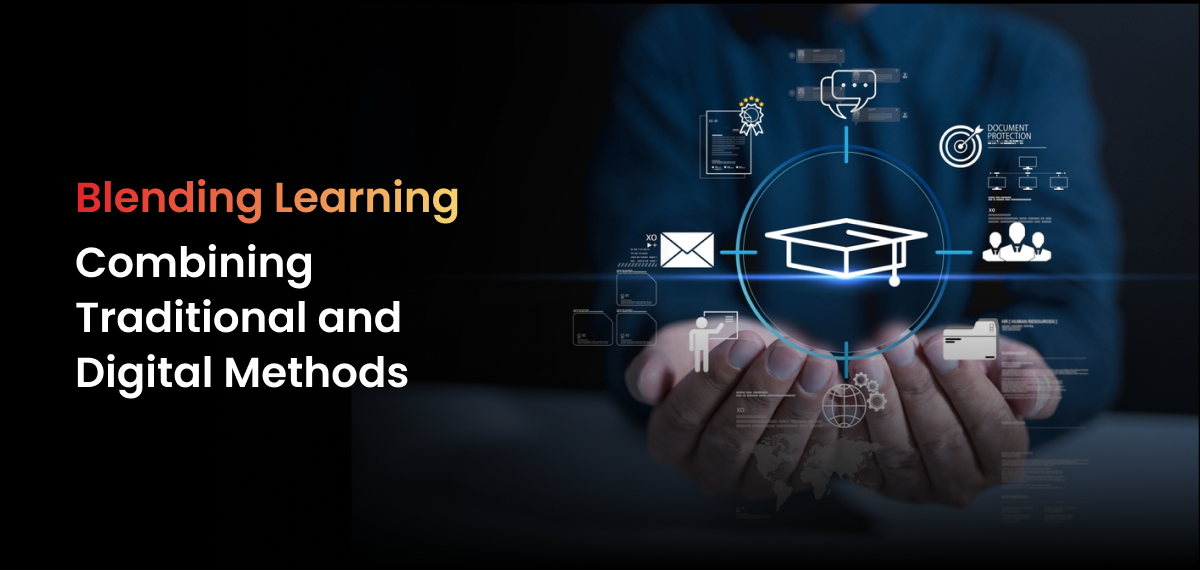Engagement Module
Next Gen AI Solution
Maintenance
Designing
Consultant
Industries
Blended Learning: Combining Traditional and Digital Methods

Blended learning is revolutionizing education by integrating traditional face-to-face teaching methods with digital technologies. This hybrid approach leverages the best of both worlds, aiming to provide a more engaging, flexible, and effective learning experience. Here, we’ll explore what blended learning is, its benefits, challenges, and how it can be successfully implemented in various educational settings.
The Components of Blended Learning
1. Face-to-Face Instruction
This involves traditional teaching methods, such as lectures, discussions, and hands-on activities conducted in a classroom setting.
2. Online Learning
Utilizes digital platforms to deliver content, including video lectures, interactive simulations, online discussions, and assessments.
Benefits of Blended Learning
1. Personalized Learning
Blended learning allows for greater differentiation in instruction, accommodating various learning styles and paces. Students can review materials as needed, take control of their learning, and receive immediate feedback from online assessments.
2. Flexibility and Convenience
This approach offers students the flexibility to access learning materials anytime and anywhere, making it easier to fit education into their busy schedules. This is particularly beneficial for adult learners, working professionals, and students with other commitments.
3. Enhanced Engagement
Digital tools and interactive content can make learning more engaging and fun. Gamified learning experiences, multimedia content, and interactive simulations can capture students’ attention and enhance their understanding of complex concepts.
4. Improved Collaboration
Blended learning encourages collaboration through online discussion forums, group projects, and social media. Students can work together, share ideas, and provide peer feedback, fostering a collaborative learning environment.
5. Efficient Use of Resources
Teachers can leverage online resources to supplement their teaching, providing students with a wealth of information beyond traditional textbooks. This can include open educational resources, online databases, and interactive simulations.
Challenges of Blended Learning
1. Technological Barriers
Not all students have access to reliable internet or digital devices, which can create a digital divide. Ensuring equitable access to technology is crucial for the success of blended learning.
2. Teacher Training
Teachers need to be proficient in using digital tools and designing online content. Professional development and ongoing support are essential to help teachers adapt to blended learning environments.
3. Student Motivation
Online learning requires a high degree of self-motivation and discipline. Some students may struggle with time management and staying on task without the structure of a traditional classroom.
4. Quality of Online Content
Creating high-quality online content is time-consuming and requires expertise. Educators must ensure that digital materials are engaging, accurate, and aligned with learning objectives.
Implementing Blended Learning
1. Assess Needs and Goals
Start by assessing the needs of your students and the goals of your curriculum. Determine which components of your course can be delivered online and which are best suited for face-to-face instruction.
2. Choose the Right Tools
Select digital tools and platforms that align with your instructional goals and are user-friendly for both teachers and students. Popular tools include learning management systems (LMS), video conferencing software, and interactive content creation tools.
3. Develop Engaging Content
Create engaging and interactive online content that complements your in-class instruction. This can include video lectures, quizzes, discussion forums, and multimedia presentations.
4. Provide Training and Support
Ensure that teachers receive adequate training and support to effectively implement blended learning. This can include professional development workshops, online tutorials, and a dedicated support team.
5. Monitor and Evaluate
Regularly monitor the effectiveness of your blended learning program through student feedback, assessments, and performance data. Use this information to make continuous improvements to your instructional approach.
Blended learning offers a powerful approach to education that combines the strengths of traditional and digital methods. By providing flexibility, personalized learning experiences, and enhanced engagement, it holds the potential to transform education and better prepare students for the demands of the modern world.
However, successful implementation requires careful planning, adequate resources and ongoing support. By addressing the challenges and leveraging the benefits, educators can create a dynamic and effective blended learning environment that meets the diverse needs of their students.
At Braincuber, we specialize in providing comprehensive solutions to help educational institutions implement and optimize their blended learning programs.
Connect with us to learn how we can support you in creating a transformative learning experience for your students. Contact us today to get started!



